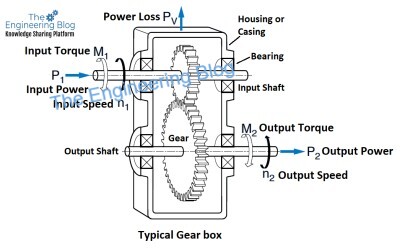Importance of Gearbox in a Machine
Gearboxes are devices for the transmission or translation of movement. In industry, gearboxes are used to transform the speeds and torques produced by the prime mover in order that they are appropriate to the machine which is to be driven. The speeds and torques required by the machine are dictated by its use. Prime movers can generally only meet these requirements when combined with gears. Gearboxes are characterized by having at least three members: the power input, power take-off, and the casing. The casing transmits the support moment to the base.

Why Fits and Tolerances are important for a gear box
Selection of correct fit, tolerances, form accuracy, and surface roughness are equally important to the design of gear. Even if gears are designed properly based on load calculation the improper Geometric dimensions and tolerances on the Gearbox shaft and housing where bearings are mounted will not result in desired life of the gearbox.
Fit and Tolerances value depend on the gearbox application details, type of bearing type, size of the shaft, size of housing (casing), bearing functionality (locating or non-locating), and Shaft design (solid shaft or hollow shaft).

Consequences of the wrong section of Fits and Tolerances in gearbox shaft and housing
There can be various conditions for wrong fits and Tolerances on a gearbox shaft and housing.
- > Oversize shaft diameter
- > Undersize shaft diameter
- > Oversize housing bore
- > Undersize housing bore
- > Form, position, and roughness issue
Oversize shaft diameter–
Bearing inner rings expand after fitting to the shaft so if the shaft is oversize then the inner ring will expand beyond desired limits and bearing internal clearance will be reduced drastically. Clearance will further reduce during the running of the gearbox due to the rise in bearing temperature. Ultimately, the bearing will lead to failure due to seizure and finally, failure of the gearbox may happen. In some cases, even the inner ring of the bearing may crack during installation due to an oversize shaft.
Undersize shaft diameter-
If the shaft size is less than the bearing inner ring will not have enough grip on the shaft and the ring will rotate at its position during the running of the gearbox. This will damage the gearbox shaft as well as the bearing. Also, the bearing may shift from its position on the shaft and which will affect gear meshing and may cause vibrations from the gearbox and temperature rise.

Oversize housing bore-
Due to the Oversize housing bearing, the outer ring will remain loose inside the housing. The outer ring will rotate at its position and may also shift in the axial direction. It will cause damage to the gearbox housing and bearing which will affect gear meshing and may cause vibrations from the gearbox and temperature rise.
Undersize housing bore-
Undersize housing will have a similar effect on the outer ring of the bearing like the oversize shaft will have on the inner ring of the bearing. Clearance of the bearing will be reduced, and the bearing will lead to failure by seizure, and gearbox failure may also happen due to vibrations and improper gear meshing after bearing failure
Form, position, and roughness issue-
The seating of the bearing (on shaft and housing) must not be uneven, causing distortion or an out-of-round condition. So along with the sizes of Shaft and Housing of the gearbox the Cylindricity, Rectangularity, and Surface roughness are also equally important. In case of cylindricity out of limits the bearing, rings will be deformed due to the pinching effect at the shaft where the diameter is high. Similarly, rectangularity is important for the bearing side face to match with housing and shaft. Surface roughness is also related to proper fitment of bearing on shaft and housing so its value should be within recommended limits.
Recommended Fits and Tolerance
The rings of rolling bearings deform elastically under load and adapt themselves to their seating. To be able to fully exploit the load-carrying capacity and accuracy of the bearings, the bearing rings must be supported with sufficient firmness and accuracy by the associated components. Where the load rotates with respect to the ring, the ring should have an interference fit on or in its seating (shaft, housing, or gear). This prevents a loosening of the bearing fit and the ring will not ‘‘wander” under load. Fretting corrosion will also be prevented. It is not possible to provide a sufficiently tight fit for the ring simply by clamping it axially.
Bearings such as Spherical Roller Bearings and Deep Groove Ball Bearings can be used as locating as well as non-locating so tolerances must be chosen accordingly.

